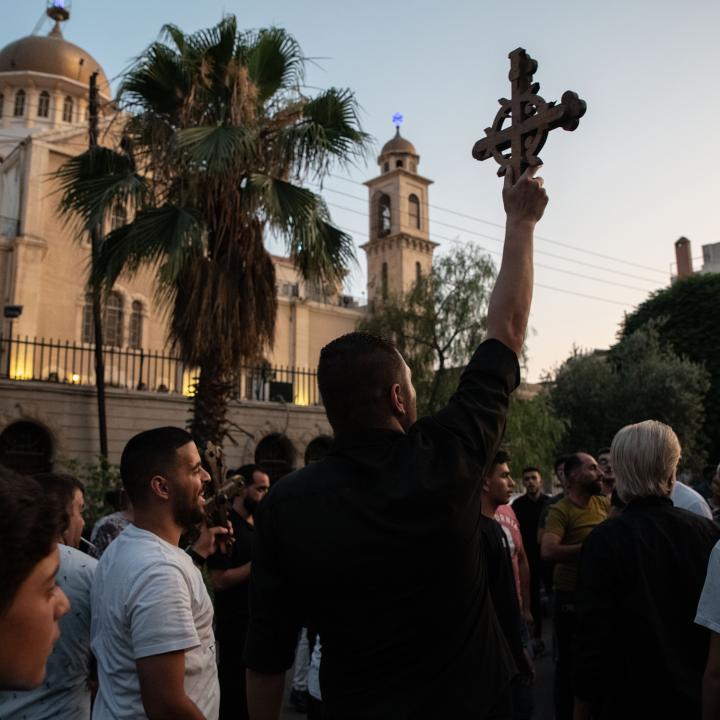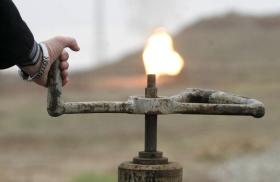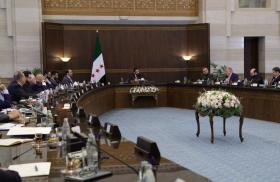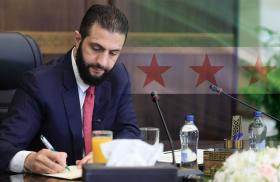
- Policy Analysis
- PolicyWatch 4063
The Damascus Church Attack: Who Is Saraya Ansar al-Sunnah?

Although definitively identifying the group responsible for the bombing may take more time, authorities in Damascus and Washington already have more than enough information to beef up their security cooperation and reassure Syrian minorities that they won’t be targeted.
On June 22, a suicide bomber targeted the Mar Elias Greek Orthodox church in the Damascus neighborhood of Dweila, killing at least twenty-five people and injuring sixty-three—the largest attack against Syria’s Christian community since 1860. The following day, Syrian authorities claimed that the Islamic State was responsible, though IS outlets have not said anything about the attack so far. On June 24, the little-known group Saraya Ansar al-Sunnah (SAS) claimed responsibility for the incident, named the bomber (Muhammad Zain al-Abidin, aka Abu Uthman), and described the attack as a response to the government’s prohibition on unapproved dawa (proselytization) efforts in the neighborhood. Notably, the ban was issued after Salafists tried to proselytize in front of Mar Elias in late March, which may indeed have been why this particular church was targeted. Whatever the case, the incident raises questions about the safety of minorities in the new Syria, the connections between jihadist elements, and the wider security situation.
Who Is Saraya Ansar al-Sunnah?
It is not yet possible to draw concrete conclusions about SAS, especially amid apparent obfuscation by the group itself as well as IS and the Syrian government. Given its profile, SAS could plausibly be regarded as an information operation, an IS front group, or an HTS splinter that radicalized back into Salafi jihadism after the fall of Bashar al-Assad’s regime.
The information known so far indicates that SAS is led by Abu Aisha al-Shami and sharia official Abu al-Fatah al-Shami. Since Assad’s ouster, it has primarily focused on attacking former regime members, often publishing the names and pictures of potential assassination targets on Telegram. It also warned President Ahmed al-Sharaa’s new government not to obstruct its operations, once again using Telegram to identify any officials deemed to be impeding the assassination campaign. This online “wanted list” approach could indicate that SAS is more of a decentralized network of lone actors than a formal organization.
The roots of SAS stretch back to before the regime’s fall, when it was allegedly part of Hayat Tahrir al-Sham and helped HTS recruit cells to operate inside Assad-held territory. Yet SAS fell out with HTS over the latter’s policy of releasing regime personnel who were taken prisoner during last year’s final offensive against Assad. SAS also accused the new HTS-led government of not ruling according to Islamic law, calling them apostates. In late January, SAS officially began publicizing its presence as a separate entity, though it claims to have been conducting assassinations since the regime’s fall. There are also indications that it absorbed some members of the former al-Qaeda branch Huras al-Din, which dissolved in late January.
The connections between SAS and IS are more complicated. SAS has signaled an affinity for IS and would not be opposed to working with the organization on ideological grounds. Yet it denies being part of IS, and pro-IS supporters online have told followers to avoid SAS. At the same time, SAS has a media outlet called the “Dabiq News Foundation”—which shares the name of a town that IS has long been obsessed with for apocalyptic religious reasons, and also echoes the title of the IS English-language magazine Dabiq.
Similar dynamics and connections were seen during the Assad era. For instance, the group Jaish Khalid bin al-Walid operated as an IS front in the Deraa area and later became the Islamic State’s official “Hawran province.” In Idlib, two other allegedly independent jihadist groups were in contact with IS while conducting attacks in 2020-21: Saraya Ansar Abu Bakr al-Siddiq (which repeatedly targeted the Turkish military checkpoints that divided HTS territory from the Assad regime) and Jamaat Abdullah bin Unais (which attacked HTS directly). More recently, following President Sharaa’s May meeting with President Trump, an editorial in the IS newsletter al-Naba called on former HTS members and foreign fighters to join its ranks and oppose the new “apostate” government in Damascus.
The Government’s Response
The Syrian government has been swift and united in condemning the church attack. In addition to appropriate statements from top political and religious officials, civil defense units quickly assessed the damage at the site, while Damascus Governor Maher Marwan (Sharaa’s brother-in-law) and Social Affairs Minister Hind Kabawat (a Christian herself) visited the church and met with neighborhood residents. Sharaa also offered condolences over the phone to Greek Orthodox Archbishop Romanos al-Hannat.
Meanwhile, personnel from the Interior Ministry and General Intelligence Directorate carried out an operation against an IS cell in Harasta and Kafr Batna the day after the bombing. Six individuals were arrested during the raid, two others were killed, and various weapons, ammunition, explosive vests, and mines were seized. A motorcycle loaded with explosives was also found ready for detonation. Apparently, the cell was planning to follow up the church bombing with an attack on the Shia shrine of Sayyeda Zainab near Damascus—something IS reportedly attempted to do in January as well. Yet SAS disputed the government’s narrative.
After further investigation, the Interior Ministry disclosed more details about the cell a day later, claiming that SAS was fictitious and that the attack was carried out by IS. Authorities also noted that the cell’s ringleader was Muhammad Abd al-Ilah al-Jumayli (aka Abu Imad al-Jumayli), a resident of al-Hajar al-Aswad (where IS previously had robust networks) and, allegedly, the IS “province” leader for the Homs desert region. Despite these claims, however, it would not be surprising if the bombing cell and SAS in general were in fact an HTS splinter group whose existence the government is hoping to obscure for obvious political and diplomatic reasons, even if they have not been associated for seven months.
In addition, the government claimed that the church attacker and attempted shrine attacker had previously been in al-Hol camp in northeast Syria. If true, this finding could create more tension in the government’s already complicated relationship with the Syrian Democratic Forces (SDF), the Kurdish-led U.S. partner group that has been in charge of the camps for years and is in the midst of a sensitive integration process with the new Syrian military.
Policy Implications for Damascus and Washington
While Syria’s government might view the steps it has taken so far as sufficient, many minority figures suspect that Damascus was somehow complicit in the attack. Such beliefs are prevalent even after the government visibly beefed up security in Christian neighborhoods in general and churches during Christmas, Good Friday, and Easter.
More broadly, the wounds of fourteen years of civil war and fifty-four years of totalitarian, sectarian rule will not be resolved in just a few months. This realization helps explain why so many Syrian activists criticized the new government for its so-called “national dialogue” in February, which lasted only a day. The fear and trauma among Christians and other minorities are also understandable considering both the past track record of HTS prior to its transformation and the March 6 massacre of Alawites that some government security elements took part in. The results of the official investigation into that massacre are supposed to be published in mid-July; now more than ever, it is crucial that the public views this report as transparent and credible.
In addition, the government itself faces ongoing threats from its far-right Salafist flank. Given the relative moderation of HTS leaders and the decisions they have made once in power (e.g., the dawa ban), observers worry that some elements of the former group may be disgruntled with its new direction after working to establish an “Islamic Emirate” during the civil war. To address such risks, Damascus has correctly prioritized gaining control of weapons outside the state’s control, but this will be a long process due to the effects of the civil war, so other measures must be employed as well.
Another big question is whether the church bombing cell will be a one-off case or a recruitment opportunity to expand SAS and conduct more attacks. If the group turns out to be a distinct entity and the government takes the threat seriously, then SAS could fizzle out in short order, much like Saraya Ansar Abu Bakr al-Siddiq and Jamaat Abdullah bin Unais eventually did in Idlib once HTS actively combated them. Obviously, though, securing an entire country is a much greater challenge than securing one province. Only time will tell if this is the start of a new campaign or the beginning of the end for a group like SAS—especially now that its name is on the radar of international authorities.
Alternatively, if SAS is an IS front, then the United States and its partners will need to assess whether Islamic State leaders are once again trying to underreport their attacks in order to mask their real strength. Washington should also take the following steps:
- Urge President Sharaa to visit the church to alleviate the Christian community’s concerns.
- Urge the Syrian government to help refurbish the destroyed church.
- Continue urging the Syrian government to devote serious attention to transitional justice and truth and reconciliation.
- Do more to assist the integration process between Damascus and the SDF, including efforts to enhance intelligence sharing related to al-Hol camp, which might have averted the church attack.
- Give Damascus actionable intelligence on terrorist activity whenever possible, as seen when U.S. information helped break up previous IS plots at Maaloula Church and Sayyeda Zainab.
- Reconsider any plans for swift U.S. military withdrawal from Syria until there are sustainable solutions to these security issues.
Through it all, U.S. officials should never forget the central purpose of attacks like the church bombing: to stoke perpetual intercommunal distrust. This is why stopping such plots is crucial to giving Syrians the space they need to heal the trauma created by the former regime and historical incidents.
Aaron Zelin is the Gloria and Ken Levy Senior Fellow at The Washington Institute and creator of its interactive Islamic State Worldwide Activity Map.



